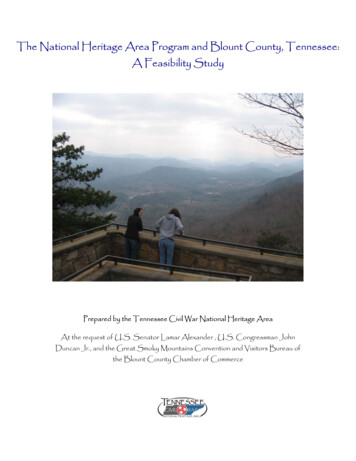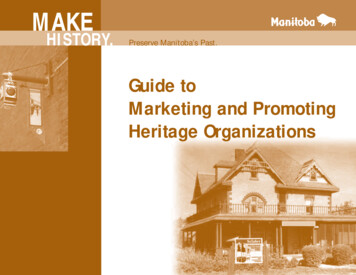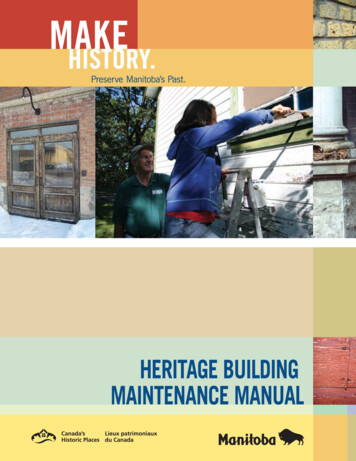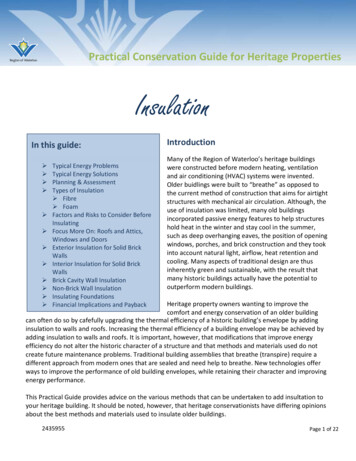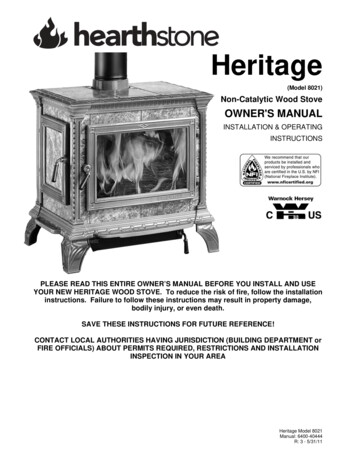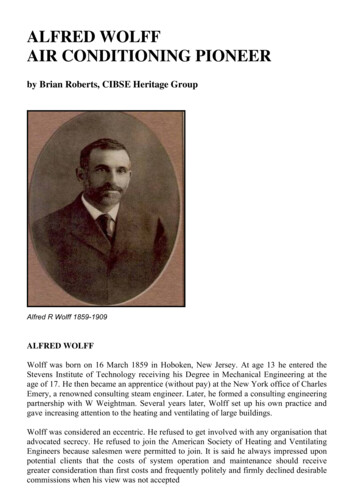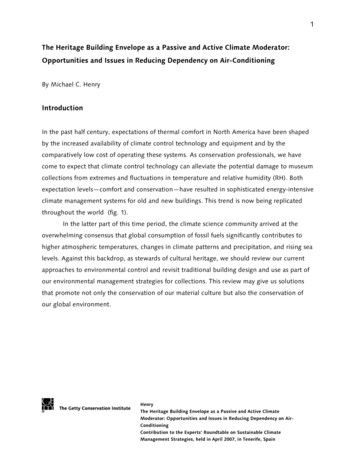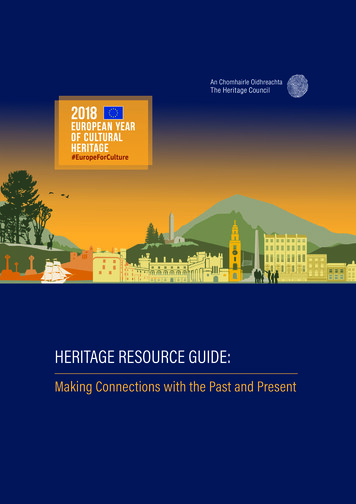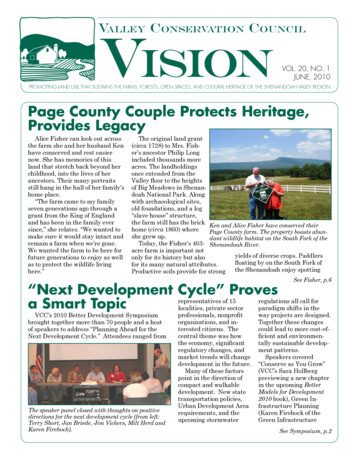
Transcription
Valley Conservation CouncilVisionVol. 20, No. 1June, 2010Promoting land use that sustains the farms, forests, open spaceS, and cultural heritage of the Shenandoah Valley regionPage County Couple Protects Heritage,Provides LegacyAlice Fisher can look out acrossthe farm she and her husband Kenhave conserved and rest easiernow. She has memories of thisland that stretch back beyond herchildhood, into the lives of herancestors. Their many portraitsstill hang in the hall of her family’shome place.“The farm came to my familyseven generations ago through agrant from the King of Englandand has been in the family eversince,” she relates. “We wanted tomake sure it would stay intact andremain a farm when we’re gone.We wanted the farm to be here forfuture generations to enjoy as wellas to protect the wildlife livinghere.”The original land grant(circa 1728) to Mrs. Fisher’s ancestor Philip Longincluded thousands moreacres. The landholdingsonce extended from theValley floor to the heightsof Big Meadows in Shenandoah National Park. Alongwith archaeological sites,old foundations, and a log“slave house” structure,the farm still has the brick Ken and Alice Fisher have conserved theirhome (circa 1860) wherePage County farm. The property boasts abunshe grew up.dant wildlife habitat on the South Fork of theToday, the Fisher’s 463- Shenandoah River.acre farm is important notyields of diverse crops. Paddlersonly for its history but alsofloating by on the South Fork offor its many natural attributes.the Shenandoah enjoy spottingProductive soils provide for strongSee Fisher, p.6“Next Development Cycle” Provesrepresentatives of 15regulations all call fora Smart Topiclocalities, private sectorparadigm shifts in theVCC’s 2010 Better Development Symposiumbrought together more than 70 people and a hostof speakers to address “Planning Ahead for theNext Development Cycle.” Attendees ranged fromThe speaker panel closed with thoughts on positivedirections for the next development cycle (from left:Terry Short, Jan Briede, Jim Vickers, Milt Herd andKaren Firehock).professionals, nonprofitorganizations, and interested citizens. Thecentral theme was howthe economy, significantregulatory changes, andmarket trends will changedevelopment in the future.Many of these factorspoint in the direction ofcompact and walkabledevelopment. New statetransportation policies,Urban Development Arearequirements, and theupcoming stormwaterway projects are designed.Together these changescould lead to more cost-efficient and environmentally sustainable development patterns.Speakers covered“Conserve as You Grow”(VCC’s Sara Hollbergpreviewing a new chapterin the upcoming BetterModels for Development2010 book), Green Infrastructure Planning(Karen Firehock of theGreen InfrastructureSee Symposium, p.2
VCC Unveils “Conserve as You Grow”The upcoming Better Models forDevelopment in the ShenandoahValley 2010 book will have a muchexpanded chapter, “Conserve asYou Grow” to present conceptslike smart growth, green infrastructure, and environmental sitedesign.“This is not about conservation OR growth,” says Sara Hollberg, who is producing the book,“but about connecting them andencouraging both in a positiveway.” The reasons to do this havemultiplied, from all directions, andthe tools are getting better andbetter. The book will bring this outand provide lots of examples andillustrations.Conserve as You Grow canapply at any scale. On the landscape level, reducing sprawl canencourage better use of development areas while maintaining theintegrity of rural resources and thefarm economy. Within the growthareas, building at a higher densitycan be balanced by opportunitiesto protect the environment, provide recreation, manage stormwater, and enhance quality of life.The same can apply in site design,as shown in the picture below.Balancing Growth and Conservation: Standard development (left) overrides natural features whereas environmental site design (right) mixes density and conservation to provide distinctive living and community space.Symposium (continued from page1)Center), State Stormwater Regulations (Jan Briede, StormwaterOutreach Manager with theVirginia Department of Conservation and Recreation), Developer’sPerspective (Jim Vickers, CEO ofOakCrest Companies), New VDOTStandards: Connectivity, AccessManagement, 527 Traffic ImpactReview, and Context Sensitive Solutions (Terry Short, Acting Planning Manager for VDOT StauntonDistrict), and Urban DevelopmentAreas 101 (Milt Herd of HerdPlanning and Design).The Conserve as You Grow andGreen Infrastructure presentations showed how planning forconservation can play a critical Valley Conservation Counciland positive role in overall community development. Developer JimVickers emphasized that developers will build what they believethey can sell, which he thinks willbe closer-in, smaller, multi-purpose projects. Short’s eye-catchingpresentation showcased VDOT’sresources to help integrate landuse and transportation. UrbanDevelopment Area (UDA) densityand design requirements and newstormwater regulations likewisewill encourage new paradigmsin site design. As one speakerremarked, it is heartening to seesuch diverse players pulling in thesame direction.In the input session, localitiesdescribed how they are movingin this direction. The hurdles areconsiderable, however, startingwith funding for infrastructure(particularly sewer) to supportcompact development and ensuring local readiness in terms ofcodes, developer expertise, andacceptance of density.VCC thanks these excellentspeakers for their time and expertise. The presentations and moreinformation can be found at www.valleyconservation.org/BetterDev Symposium 2010.html or bycontacting VCC at 540.886.3541.www.valleyconservation.org
Virginia’s Preservation Trust Fund (PTF)Change Helps Working Lands EasementsEven with Virginia’s strong incentives for donating role for many years. Once easement activitying conservation easements, many landowners havereally heated up about five years ago, VCC was beingdifficulty moving forward with an easement whencalled on to hold as many as 20 or more easementsfacing upfront legal and appraisal costs of roughlyeach year with VOF. We were honored to assist so 3,000-7,000. For those landowners who qualify,many families who chose to protect their land in thisVirginia’s Open-space Lands Preservation Trustway.Fund (PTF) may help by reimbursing those up-frontSenator Emmett Hanger successfully championedcosts. Funding levels vary year to year.legislation in the 2009 session that removed theThe Valley region has had a high number of landrequirement for local co-holders on PTF easements.owners who qualified to use the fund. Often these areThis proposal has now greatly simplified the processowners of farms and forestlands that have been infor VOF and the landowners they work with andtheir families for generations. VCC is proud to havereduced substantial duplication of effort between coassisted on 74 of these PTF easements covering moreholding organizations.than 15,700 acres.In 2009 VCC workedWith VCC’s urgwith VOF to hand overing and support, theor “assign” our interestPTF was set up byin almost all of our PTFthe General Asco-holds to VOF. Oursembly in 1997. Byrecord keeping, moniall accounts the usetoring, and stewardshipof PTF support hasresponsibilities were allbeen a tremendoussignificantly reducedsuccess. Not onlyby this administrativehas the fund helpedchange while addingreimburse upfrontno additional burden tocosts for landownVOF. The lands remainers across the Comvery well protected.monwealth, it hasWe appreciate thealso been tapped toleadership of Senatorprovide much neededHanger and the helpmatching funds thatof the many legislatorscombine with federal Jill Templeton, VCC’s Program Manager, monitoring anwho are working todollars to make occa- easement during the spring thaw and rainy season.maintain strong easesional purchased easement incentives andments possible. For example, as we reported in 2008,the capacity of state agencies to support voluntaryPTF support was matched by money from USDA toland conservation for the long-term benefit of thepurchase an easement on Dorothy Lee Rosen’s farmCommonwealth’s citizens. We also owe a great debton the Augusta/Rockingham borderof thanks to the team at VCC—program manager JillThe original PTF legislation required VOF to alTempleton, intern Sandra Bottoms, and our volunways have a local organization or government entityteer attorney, Tom Lockhart—who worked tirelesslyco-hold the easements. VCC has served this co-holdto make this transition possible.Best Wishes, Jill - VCC’s Program Manager, Jill Templeton, left her position in May to pursue otherpriorities. Jill has been responsible for moving VCC forward as a land trust by leaps and bounds. During hertwo years with the organization she helped revamp our easement acquisition and stewardship policies andprocedures and moved us along the trail toward accreditation. Our future easement work will be built on thefoundation Jill has provided. Everyone at VCC wishes Jill the very best in her future endeavors.www.valleyconservation.orgValley Conservation Council
VCC Celebrates 20 YearsThe celebration of ValleyConservation Council’s 20thyear kicked off with an evening banquet at the Stonewall Jackson Hotel backin February and continueswith other events throughout the region.“When we started therewasn’t even a Virginia Outdoors Foundation (VOF) office serving the Valley,” saysFaye Cooper, VCC boardVCC Founding Members: (Left to right),member and one of ourSteve Talley, Emily Smith Talleyfounders. Today the VOF of(standing in for the late McKelden Smith),fice in Staunton reports thatMark Hollberg, Sara Hollberg,the Valley region boastsRick Chittum, Bobby Whitescarver,four of the top ten countiesFaye Cooper, Jim Brownin Virginia for permanentlyconserved acreage.People make it all happen and without our long-time members andthe landowners who have done so much, none of this would have beenpossible. VCC will continue to identify and fill the gaps in the conservation quilt that covers the Valley region. We look forward to what thenext 20 years will bring.Many thanks to the many event sponsors and to those who donateditems for our silent auctions. Thanks also to the 20th AnniversaryCommittee–Faye Cooper, Ann Kelly Morse, Mark Hollberg, BobbyWhitescarver, Steve Talley, Kurt Kunze, Denman Zirkle, and Genevieve Goss–for their tireless efforts resulting in the huge success ofthe kick-off celebration in Staunton. Our volunteers Carolyn MooreFord and Liz McCue, and special consultant Paulyn Heinmiller andmany others who helped out that evening also deserve a sincere“thank you.”Bill Noack Returns to VCCBoardAt VCC’s February Boardmeeting, William H. Noack wasappointed to the VCC Board ofDirectors. Bill and his family liveon a small farm in Maryland buthe is no stranger to the Valley. Infact he previously served on theboard. At that time the Noacksowned Brandenberg, a conservedhistoric farm in the Middlebrookto-Brownsburg Corridor area of Valley Conservation CouncilAugusta County. Prior to thatthey had another historic home inPage County for many years.Bill Noack recently formed hisown consulting firm following a37-year career with General Motors Corporation. He was GM’sdirector of public policy communications, based in Washington,D.C. Please join us in welcomingBill back to the VCC Board!New MembersAugusta County/Staunton/WaynesboroABL Landscape ArchitectureJennifer Coffman & Fletcher LinderCommunity BankDockery Clinic of ChiropracticEdwardJonesKen FanfoniFirst Bank & Trust CompanyVera Hailey & Chris ValenzuelaJennings Gap, Inc.Becky KohlerQuality Inspection ServiceRose Cliff Garden ClubShreckhise ShrubberyBotetourt CountyStephen ClintonRockbridge CountyWilliam D. PayneRockingham County/HarrisonburgVictoria Bakker and Tony HartshornChuck BarilCrawford Financial GroupBarbara McKeeFrom AfarL.S. and J.S. Bryan FundJason EspieMichael KellyMary-Jane NaseIda RademacherDavid SchwartzW.T. Steele, IIIClint StretchSpecialAnniversary Membership Ratefor New Members!tt 20 Years tttt 20 Bucks ttJoin VCC this year for only 20Give the gift of conservation tofriends and relatives.www.valleyconservation.org
Valley Landowners Conserve More Than11,000 Acres in 2009The pace of land conservation in the Shenandoah VOF Conservation Easements in Area Served by VCCValley region increased significantly in recent20092009Cumulative Acresyears, and 2009 was no exception. LandownersCountyEasementsAcresplaced permanent conservation easements withAlleghany6,326the Virginia Outdoors Foundation (VOF) on more393815,244than 11,000 acres. Rockbridge County continues to Augustabe a leader in the Commonwealth with 15 conserBath458319,347vation easements completed last year, more thanBotetourt44,15314,746any other county. In another notable accomplish23534,565ment, Augusta County now has a cumulative total FrederickHighland61,1939,390of more than 15,000 acres of privately protectedland.Page25021,733Over the past four years, the Shenandoah ValRockbridge153,06831,968ley region has become a prime area for land conRockingham2,654servation. Former Governor Tim Kaine achievedShenandoah33483,636his goal of conserving an additional 400,000 acres,Staunton (City)3and much of this was due to the strong commitment of landowners in the Shenandoah Valley.Warren2986,248While other land trusts, including the ValleyWinchester115Conservation Council, hold some conservationVCC Region4111,235115,974easements, VOF holds the vast majority in Virginia and its activities are the best general indicatorof land conservation activity. For the fourth consecutive year, VOF conserved more than 50,000 acres.This public land trust now holds more conservationeasements than any other land trust in the nation,protecting more than 580,000 acres.Valley Helps Meet Kaine’sFour-Year GoalContinuing a Good IdeaGovernor McDonnellSets Goal to Conserve400,000 More AcresGovernor Bob McDonnell made land conservationa top priority for his administration by setting a goalto conserve 400,000 acres in his keynote address atthe Environment Virginia Symposium in April. Thiscontinued commitment makes Virginia a leader inland conservation building on the successful protection of 400,000 acres during the previous term. Thegoal includes public acquisition of land and privateindividuals entering into conservation easements.Achieving such ambitious benchmarks requires ateam approach with involvement from all levels ofgovernment—federal, state, and local—as well asprivate land trusts such as the Valley ewide Goal:400,000 acresConserved Total:428,587 acresShenandoah ValleyRegion:Top County:89,172 acresRockbridge with30,673 acres(Includes easements, parks, preserves andother conserved lands.)Source: Virginia Department ofConservation & RecreationThese strong public and private partnerships willprove more important for the next 400,000 acresgiven the severely strained state and local budgets.The last 400,000 acres were conserved in large partdue to a financial commitmentSee Goal, p.7Valley Conservation Council
Fisher (continued from page 1)A conservation easement isan excellent way to protectland and to make sure itwill be here for generationsto come. Alice Fisher, Page County easement donorsong birds in more than 7,000 feet of the well-forested stream banks. Bald eagles soar overhead.The property serves as a significant wildlife corridor along the river.The Fishers considered various ways to protecttheir land and attended a workshop VCC held inLuray. VCC shared the pros and cons of conservation easements and connected the Fishers withKristin Ford of the Virginia Outdoors Foundationwho worked with them through the details of theireasement. VOF holds the easement on the landwhich limits all future owners to only one divisionof the property.View from the Fisher property along thebanks of the Shenandoah RiverUp & Down the ValleyNew Gas Drilling Proposed in the ValleyThe Rockingham County Board of Supervisors isconsidering a special use permit request for the first“hydrofracking” gas well drilling site in the Valleyregion. This process uses large quantities of waterwhich then must be treated. Significant concerns havebeen raised about water supply and the potential forpollution of surface and groundwater as well as impacton a swath of the Valley that has particularly highenvironmental and recreational value. But we believethe Rockingham County Board of Supervisors hasevery reason to promote this drilling to create a moresustainable local budget.The Marcellus Shale formation, which holds potentially profitable natural gas deposits, underlays portions of western Shenandoah, Rockingham, Augusta,Botetourt and Rockbridge counties and extensive areasof Highland, Bath and Alleghany as well as most ofWest Virginia. Further information on the Rockingham permit and this form of gas extraction is available from the Community Alliance for Preservation atwww.preserverockingham.orgSeveral states have raised concerns about the process. New York has halted drilling while further studyis underway and EPA is considering hydrofracking’simpacts. Beyond the environmental concerns, substantial heavy truck traffic, forest fragmentation and publicsafety issues have also been raised in many communities.Augusta Passes Zoning PackageThe Augusta County supervisors in Februaryadopted a sweeping zoning ordinance update that,among numerous changes, did away with ExclusiveAgriculture zoning and added more potential uses inGeneral Agricultural zoning, many by administrativepermit. The package, developed by a board and staffcommittee, had a single public hearing in October. Weapplaud Augusta County for being on the cutting edgeof land use planning that reins in sprawl and ensuresag vitality.Rockingham County Begins Zoning UpdateRockingham has started a similar process. Its goalsare to align the codes to implement the comp planand to update decades-old language. The county hasappointed several citizen committees to help developstrategies.Historic log cabin located on the Fishers’Page County property Valley Conservation Councilwww.valleyconservation.org
Valley Conservation Council Endowment FundFund Provides an Enhanced Way toProtect the Valley ForeverThe fund is open for donations by sending a checkpayable to the Community Foundation, PO Box815, Staunton, VA 24402. For further information,contact John Eckman at VCC or Becky Kohler, CFP,President & CEO of the Community Foundation at540-213-2150VCC also has a fund established at TheCommunity Foundation of Harrisonburg andRockingham County. For information on thisfund, please contact John Eckman at VCCor Revlan Hill, Director of Development &Community Relations at the Foundation,540.432.3863.Photo Cindi JohnsonIn celebration of 20 successful years of land conservation, the Valley Conservation Council announcesthe creation of an endowment fund at the CommunityFoundation of the Central Blue Ridge. Through ourwork as the Valley’s private land trust, VCC makesa perpetual commitment to conserving land. “Thisfund,” explained Executive Director John Eckman,“provides an opportunity for our supporters to giveabove and beyond their usual annual gifts.”The creation of this fund is an opportunity for thecommunity to join in VCC’s commitment, helping toensure that scenic landscapes, clean waters, productive soils and rural heritage are part of our legacy forfuture generations. The fund will develop an endowment to help with VCC’s long-term responsibilities asa land trust. Faye and Peter Cooper have contributedto the fund and “know that many of VCC’s memberswill plan to do the same.”Goal (continued from page 5)from the Commonwealth to retain a strong, transferrable tax credit and through more modest fundingprograms such as purchase of development rights(PDR) for localities and the Virginia Land Conservation Foundation. Vi
Jun 08, 2015 · Jennifer Coffman & Fletcher Linder Community Bank Dockery Clinic of Chiropractic EdwardJones Ken Fanfoni First Bank & Trust Company Vera Hailey & Chris Valenzuela Jennings Gap, Inc. Becky Kohler Quality Inspection Service Rose Cliff Garden Club Shreckhise Shrubbery Botetourt County Stephen


